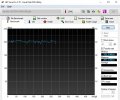HCHTech
Well-Known Member
- Reaction score
- 4,405
- Location
- Pittsburgh, PA - USA
These days, anything that hits the bench with an HDD gets a pitch to replace with an SSD. I've had two almost identical cases in the past week, hardware diagnostics pass, including no flags in gsmartcontrol, BUT computer is very slow. When drive is pulled for backup, copying data is very slow, and if cloned to an SSD, the cloning process is very slow. Computer runs like new once SSD is mounted (and transfer rates are close to spec on the SSD benchmark), no infections found or concerning errors in the logs.
This means that likely the main cause of the extreme slowness before was lower-than-normal throughput to/from the HDD. To the drive experts here, I'm curious what part is failing that doesn't show up in the SMART logs or cause short-or-long test failures, but results in depressed throughput? I've run into this before, but usually by the time you reach that conclusion, it doesn't make any sense to try and document the actual throughput - it's just replace the thing and get on with it. Since we didn't replace the cable, and did a straight clone, it can't be the cable or the storage drivers - I would think, anyway. Mostly, I'm just looking for a name to give this symptom so I can say something more intelligent than "I guess it was broken somehow" - haha.
This means that likely the main cause of the extreme slowness before was lower-than-normal throughput to/from the HDD. To the drive experts here, I'm curious what part is failing that doesn't show up in the SMART logs or cause short-or-long test failures, but results in depressed throughput? I've run into this before, but usually by the time you reach that conclusion, it doesn't make any sense to try and document the actual throughput - it's just replace the thing and get on with it. Since we didn't replace the cable, and did a straight clone, it can't be the cable or the storage drivers - I would think, anyway. Mostly, I'm just looking for a name to give this symptom so I can say something more intelligent than "I guess it was broken somehow" - haha.


